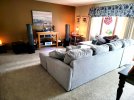dtomamichel
Member
- Joined
- Sep 30, 2021
- Messages
- 15
- Likes
- 6
Hi to all? I'm Doug Tomamichel, and new to the group.
Here is my equipment and stereo audio only room - looking forward to any ideas on improving my setup
Zero Surge
Project Debut Carbon & Oppo UDP-203 which is normally in my home theater
Pioneer DVD-V7400 (CD transport via coax to Topping D70)
HP Spectre Pro x360 G2 Convertible Touchscreen 13.3in QHD (2560X1440), i7-6600U, 8GB LPDDR3-1600, 512GB SSD, Bluetooth, WiFi, Win 10 Pro - Foobar 2000 FLAC
HP USB to Topping D70 (connections are balanced to Emotiva)
Emotiva XSP-1 (connections are balanced ) to JungSon JA-99C
Martin Logan ESL & HSU ULS-15MK2
Stax SRM-1MK2 Stax SR307 & SR-A Lambda
Here is my equipment and stereo audio only room - looking forward to any ideas on improving my setup
Zero Surge
Project Debut Carbon & Oppo UDP-203 which is normally in my home theater
Pioneer DVD-V7400 (CD transport via coax to Topping D70)
HP Spectre Pro x360 G2 Convertible Touchscreen 13.3in QHD (2560X1440), i7-6600U, 8GB LPDDR3-1600, 512GB SSD, Bluetooth, WiFi, Win 10 Pro - Foobar 2000 FLAC
HP USB to Topping D70 (connections are balanced to Emotiva)
Emotiva XSP-1 (connections are balanced ) to JungSon JA-99C
Martin Logan ESL & HSU ULS-15MK2
Stax SRM-1MK2 Stax SR307 & SR-A Lambda

